Related Research Articles

The Rough Riders was a nickname given to the 1st United States Volunteer Cavalry, one of three such regiments raised in 1898 for the Spanish–American War and the only one to see combat. The United States Army was small, understaffed, and disorganized in comparison to its status during the American Civil War roughly thirty years prior. Following the sinking of USS Maine, President William McKinley needed to muster a strong ground force swiftly, which he did by calling for 125,000 volunteers to assist in the war. The U.S. had gone to war in opposition to Spanish colonial policies in Cuba, which was then torn by a rebellion. The regiment was also nicknamed "Wood's Weary Walkers" for its first commander, Colonel Leonard Wood. This reflected their dissatisfaction that despite being cavalry, they ended up fighting in Cuba as infantry, since their horses were not sent there with them.

United States Colored Troops (USCT) were Union Army regiments during the American Civil War that primarily comprised African Americans, with soldiers from other ethnic groups also serving in USCT units. Established in response to a demand for more units from Union Army commanders, by the end of the war in 1865 USCT regiments, which numbered 175 in total, constituted about one-tenth of the manpower of the army. Approximately 20 percent of USCT soldiers were killed in action or died of disease and other causes, a rate about 35 percent higher than that of white Union troops. Numerous USCT soldiers fought with distinction, with 16 receiving the Medal of Honor. The USCT regiments were precursors to the Buffalo Soldier units which fought in the American Indian Wars.

Buffalo Soldiers were United States Army regiments composed primarily of African Americans, formed during the 19th century to serve on the American frontier. On September 21, 1866, the 10th Cavalry Regiment was formed at Fort Leavenworth, Kansas. The nickname "Buffalo Soldiers" was purportedly given to the regiment by Native Americans who fought against them in the American Indian Wars, and the term eventually became synonymous with all of the African American U.S. Army regiments established in 1866, including the 9th Cavalry Regiment, 10th Cavalry Regiment, 24th Infantry Regiment, 25th Infantry Regiment and 38th Infantry Regiment.

The Battle of San Juan Hill, also known as the Battle for the San Juan Heights, was a major battle of the Spanish–American War fought between an American force under the command of William Rufus Shafter and Joseph Wheeler against a Spanish force led by Arsenio Linares y Pombo. The battle proved to be one of the most significant battles of the war and, along with the Siege of Santiago, a decisive battle in deciding the fate of the United States Army campaign in Cuba. The American forces, outnumbering the Spanish defenders 16-to-one, charged upon the heights and dispersed the Spanish after suffering heavy casualties.

The 24th Infantry Division was an infantry division of the United States Army that was inactivated in October 1996. Formed during World War II from the disbanding Hawaiian Division, the division saw action throughout the Pacific theater, first fighting in New Guinea before landing on the Philippine islands of Leyte and Luzon, driving Japanese forces from them. Following the end of the war, the division participated in occupation duties in Japan, and was the first division to respond at the outbreak of the Korean War. For the first 18 months of the war, the division was heavily engaged on the front lines with North Korean and Chinese forces, suffering over 10,000 casualties. It was withdrawn from the front lines to the reserve force for the remainder of the war after the second battle for Wonju, but returned to Korea for patrol duty at the end of major combat operations.

The 24th Infantry Regiment is a unit of the United States Army, active from 1869 until 1951, and since 1995. Before its original dissolution in 1951, it was primarily made up of African American soldiers.

The 9th Cavalry Regiment is a parent cavalry regiment of the United States Army. Historically, it was one of the Army's four segregated African-American regiments and was part of what was known as the Buffalo Soldiers. The regiment saw combat during the Indian and Spanish–American Wars. During Westward Expansion, the regiment provided escort for the early western settlers and maintained peace on the American frontier.
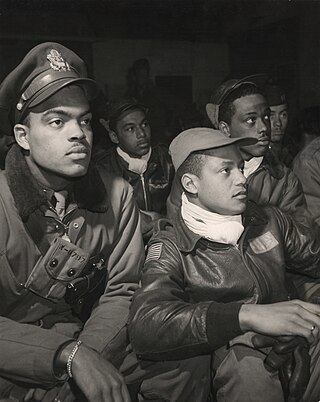
The military history of African Americans spans from the arrival of the first enslaved Africans during the colonial history of the United States to the present day. African Americans have participated in every war fought by or within the United States, including the Revolutionary War, the War of 1812, the Mexican–American War, the Civil War, the Spanish–American War, World War I, World War II, the Korean War, the Vietnam War, the Gulf War, the War in Afghanistan, and the Iraq War.

The Brownsville affair, or the Brownsville raid, was an incident of racial discrimination that occurred in 1906 in the Southwestern United States due to resentment by white residents of Brownsville, Texas, of the Buffalo Soldiers, black soldiers in a segregated unit stationed at nearby Fort Brown. When a white bartender was killed and a white police officer wounded by gunshots one night, townspeople accused the members of the African-American 25th Infantry Regiment. Although their commanders said the soldiers had been in the barracks all night, evidence was allegedly planted against the men.
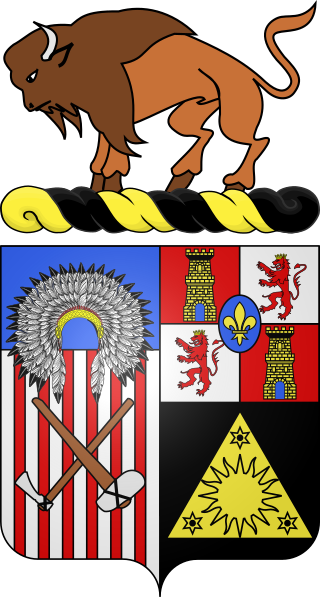
The 10th Cavalry Regiment is a unit of the United States Army. Formed as a segregated African-American unit, the 10th Cavalry was one of the original "Buffalo Soldier" regiments in the post–Civil War Regular Army. It served in combat during the Indian Wars in the western United States, the Spanish–American War in Cuba, Philippine–American War and Mexican Revolution. The regiment was trained as a combat unit but later relegated to non-combat duty and served in that capacity in World War II until its deactivation in 1944.

The 25th Infantry Regiment was an infantry regiment of the United States Army activated in 1866 and deactivated in 1957. One of the "Buffalo Soldier" units, the racially segregated regiment saw action during the American Indian Wars, Spanish–American War, Philippine–American War and World War II.

The 71st New York Infantry Regiment is an organization of the New York State Guard. Formerly, the 71st Infantry was a regiment of the New York State Militia and then the Army National Guard from 1850 to 1993. The regiment was not renumbered during the early 1920s Army reorganization due to being broken up to staff other units from 1917 to 1919, and never received a numerical designation corresponding to that of a National Guard regiment.
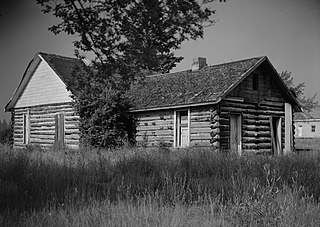
Fort Missoula was established by the United States Army in 1877 on land that is now part of the city of Missoula, Montana, to protect settlers in Western Montana from possible threats from the Native American Indians, such as the Nez Perce.
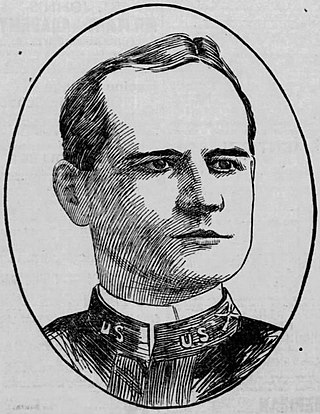
Jules Garesche "Gary" Ord was a United States Army First Lieutenant who was killed in action after leading the charge of Buffalo Soldiers of the 10th U.S. Cavalry up San Juan Hill. History now records that Ord was responsible for the "spontaneous" charge that took the San Juan Heights during the Spanish–American War in Cuba on July 1, 1898.
The Second Army Corps was a unit of the United States Army raised for the Spanish–American War. A defining event of the Spanish–American War was the typhoid fever epidemic of July to November 1898. The Army consequently undertook a series of mass-retreats and attempted evasions. The Typhoid Board concluded that only one of the five army corps stricken with epidemic typhoid succeeded in suppressing the disease actively, the 2nd Army Corps. In the wake of two fruitless relocations and months of casualties, commanders finally managed to impose an effective latrine-policy. A three-part strategy of draconian defecation-management, mass-disinfection, and flight received the Typhoid Board's imprimatur as the principal, recommended method for suppressing existing epidemics.

The Battle of Sangju was an engagement between the United Nations and North Korean forces, occurring on July 20–31, 1950, in the village of Sangju in southern South Korea, early in the Korean War. It ended in a victory for the North Korean forces after they were able to push troops of the United States and South Korea out of the area.

Captain Lewis Cunningham Broadus (1877–1961) was a Buffalo Soldier born in Henrico County, Virginia, who served his country with distinction in the 25th Infantry Regiment and the 92nd Division of the United States Army. He served from 1897 to 1923, and was a combat veteran of the Spanish–American War, Philippine–American War, and World War I.

The 2nd Oregon Volunteer Infantry Regiment was a military regiment recruited in the U.S. state of Oregon during the Spanish–American War. As the first foreign war in U.S. history, it was the first time members of the Oregon National Guard had fought on foreign soil. The regiment also served with distinction in the Philippine–American War. At full strength, it was composed of 50 officers and 970 enlisted men. The regiment's last company was mustered out of service in August 1899.
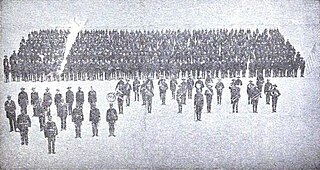
The Third North Carolina Regiment was an American military unit composed of colored troops from North Carolina mustered into federal service in the Spanish–American War. Unlike most regiments at the time, it was entirely led by black officers. The unit did not see active service in conflict and spent most of its existence in camps in North Carolina, Tennessee, and Georgia.
George William Ford was a U.S. military officer in the Spanish American War and a Buffalo Soldier. Born in Alexandria, Virginia, at George Washington's Mount Vernon Plantation, he joined the 10th Cavalry in 1867 at 19.
References
Books
- Leckie, William H.; Leckie, Shirley A. (2003). The Buffalo Soldiers, A Narrative of the Black Cavalry in the West. University of Oklahoma Press Press. pp. 1–31. ISBN 9780806183893.
- Schubert, Frank N. (1997). Black Valor:The Buffalo Soldiers and the Medal of Honor, 1870-1898. Scholary Resources Inc. ISBN 9780842025867.
Journal Article
- Gatewood, Willard B. (1998). "Black Troops in Florida During the Spanish American War". Tampa Bay History. 20: 17–31.